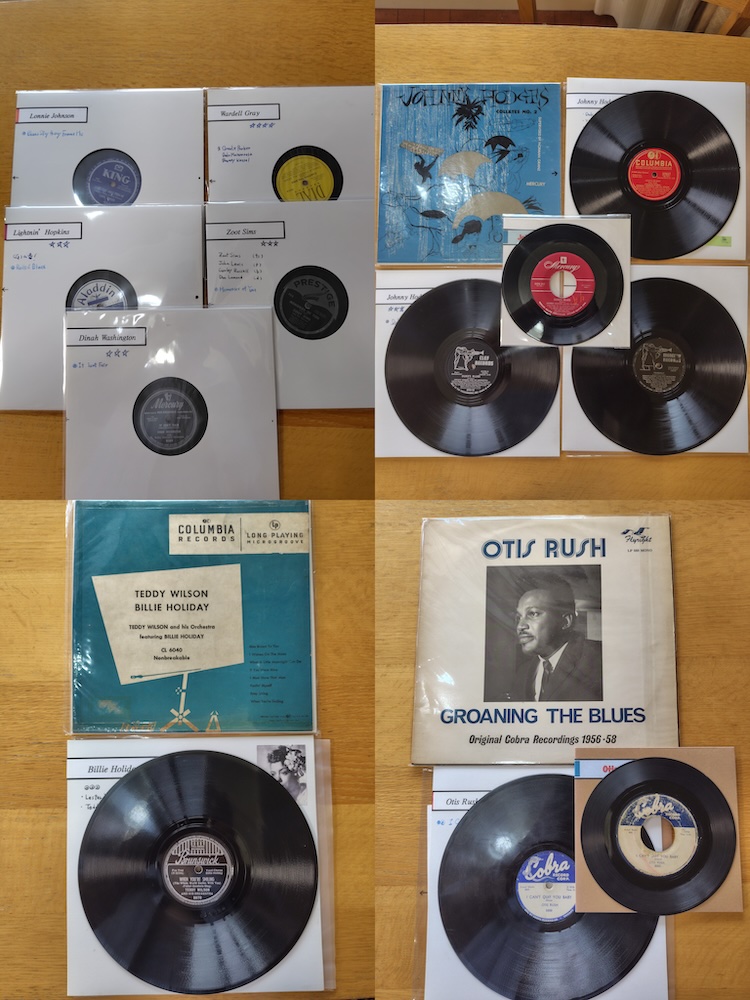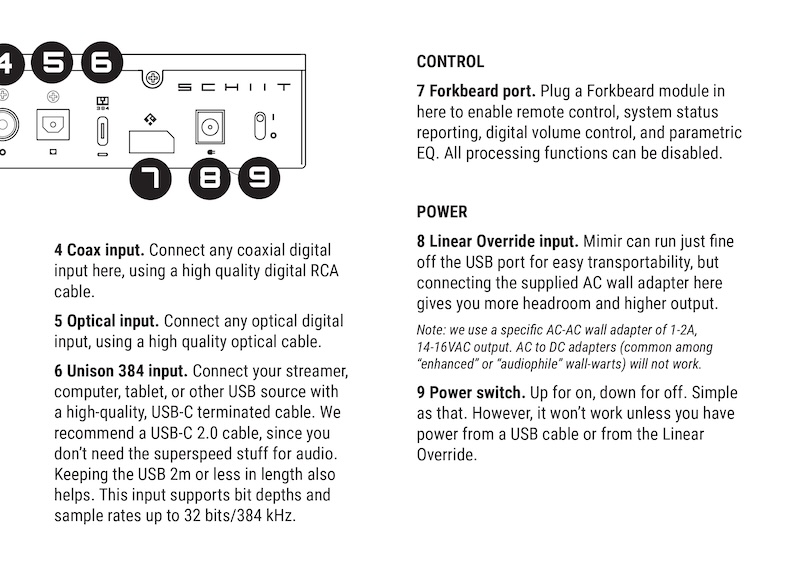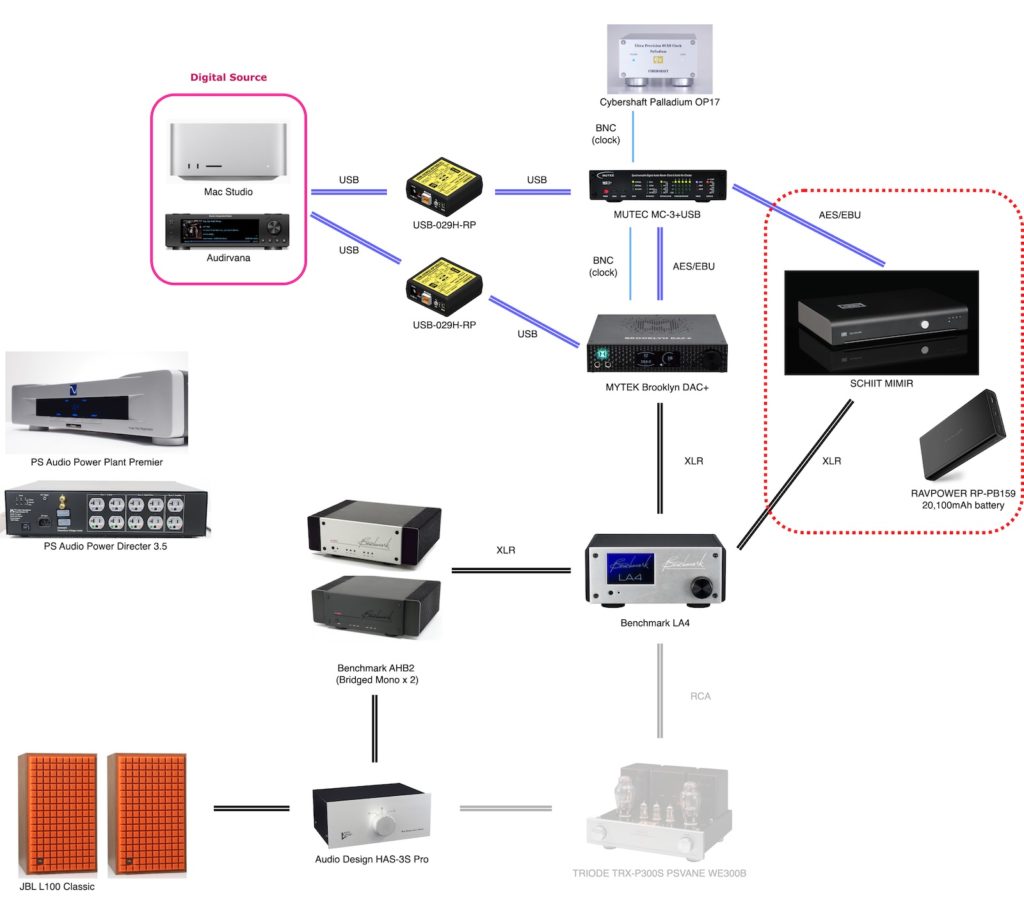Contents / 目次
Introduction
つい先日、音楽好きな知人のお宅を訪問する機会がありました。主に LP(特に 1940〜50 年代のジャズやソウル/R&Bのオリジナル盤)や 45 回転シングル盤、78 回転盤(こちらもジャズやソウル/R&Bがメイン)を愛聴されていて、CD は積極的には聴かず、PC オーディオやストリーミングにもまったく興味がない、という方です。
The other day I had a chance to visit a friend who’s a hardcore music lover. His daily spins are mostly LPs – original jazz, soul and R&B pressings mainly from the ’40s to ’50s – plus 45 rpm singles and even 78 rpms of the same genres. CDs rarely make it onto his system, and PC-based audio or streaming? Zero interest.
Billie Holiday、Johnny Hodges、Willie Smith、Aretha Franklin、Helen Merrill、Dinah Washington、Solomon Burke などを特に愛好されており、自慢のオリジナル盤 LP や SP 盤をいろいろ聴かせていただきました。
He’s especially fond of artists like Billie Holiday, Johnny Hodges, Willie Smith, Aretha Franklin, Helen Merrill, Dinah Washington, and Solomon Burke, and he treated me to a parade of prized and treasured LPs and 78 rpm records of original pressings.

(その方のコレクションの一部)
本とレコードであふれる(笑)リビングには、センス良くコンパクトにセットアップされたシステムが鎮座。さりげなく粋なコンポーネントで構成されており、トランジェント特性に優れた現代的な小型スピーカーで聴くヴィンテージ盤の音は、実に興味深いものでした。
His living room – overflowing with books and records 🙂 – houses a neatly arranged, space-saving rig. The components are understated yet stylish, and hearing vintage discs through modern compact speakers with lightning-fast transients was genuinely fascinating.
Eye-Opener
私も アナログ は大好きですが、ディジタル も等しく信頼していますから、ディジタルへの偏見を少しでも解ければ、と、自宅からノート PC と(クローゼットに眠っていた古い)DAC を念のため持参し、さまざまなディジタル音源を聴いてもらいました。
I’m another big analog fan, but I also trust digital every bit as much – I hoped to chip away at his prejudice. So I brought along a laptop and an old DAC that had been languishing in my closet, and let him audition a spread of digital tracks.
すると意外にも、「CD(というかディジタル音源)について誤解していたかもしれない、見直した」と、かなり興味を示していただけました。特に、お持ちの CD プレーヤで再生した音と、同じ CD からリッピングした音源をノートPC経由 DAC で再生した音、この両者の大きな違いにびっくりされていました。
Much to my surprise he said, “Maybe I’ve been wrong about CDs – or more precisely, digital in general. You’ve changed my mind, and I need to rethink this”, and he grew genuinely intrigued. He was especially stunned by how different the music sounded when played on his own CD player versus the very same disc ripped to the laptop and run through the DAC.
「DAC を1台用意するだけでも音は激変するかもしれませんよ、ディジタル技術の進化は本当にすごいですから」と話したところ、現在使用している CD プレーヤー Sony CDP-X3000 のディジタルアウトに接続できる DAC を選んでほしい、との要望をいただきました。そこで 2 万円〜20 万円の中からいくつか候補を挙げ、それぞれに私個人の印象を添えて提案しました。
Then I told him, “Even adding a standalone DAC can make a dramatic upgrade – digital technology has come a long, long way”. He then asked me to pick one that could hook up to the digital out of his trusty CD player, Sony CDP-X3000. I shortlisted a few units in the ¥20,000–¥200,000 (US$150–1,500) range, and added my personal take on each.
その結果、2010年創設、米国の新進気鋭のオーディオメーカ Schiit Audio が、2025年4月24日に発表 したばかりの廉価な DAC、Mimir が選出されました。わたしが代理購入し、いろいろいじり倒したあとで、最終的に知人のお宅のシステムへの設置を行う、という流れです。
As a result, the winner turned out to be the brand-new budget DAC Mimir from Schiit Audio – an up-and-coming U.S. manufacturer founded in 2010 – announced on 24 April 2025. I’d buy one on his behalf, run it through its paces, and then slot it into his system.
Schiit Mimir has arrived
で、Schiit に直接注文していた Mimir が、今朝(2025/06/25)届きました。
Fast-forward to this morning (25 Jun 2025): the Mimir I’d ordered straight from Schiit finally arrived.
さっそく我が家の環境で音出ししてみます。付属の AC アダプタは 120 V AC 専用ですが、細かいことは気にせず、とりあえず試聴。高精度外部クロックを同期させた MUTEC MC-3+USB の AES/EBU(XLR)ディジタル出力を Mimir へ入力します。
Time for a quick listen in my home system. The bundled wall wart is strictly 120 V AC, but I ignored that for the moment. I fed the Mimir from a MUTEC MC-3+USB locked to a high-precision external clock, via AES/EBU (XLR).
面倒くさいので、Brooklyn DAC+ の上に直置きで(笑)
ところが、出てきた音は、それはもうひどいものでした…。音がブツブツ途切れ、歪みも感じられ、とても聴けたものではありません。
What came out was awful—dropouts everywhere, audible distortion, essentially unlistenable.
これはなにかおかしい。電圧が 100 V と 120 V で違うとはいえ、ここまで劣化するだろうか? いや、そんなはずはない… と思いつつ、100 V 用の AC アダプタを調達して様子を見てみようかと、まずは付属アダプタの表記を確認したところ…
Sure, Japan runs 100 V while the U.S. is 120 V, but could that alone wreck the sound this badly? Doubtful. I thought about sourcing a 100 V supply and flipped the brick over to read its specs, when I noticed…
入力が 120VAC、出力が16VAC… なんと、DC出力じゃなかった!
この AC アダプタ、出力 が DC(直流)じゃなくて、AC(交流)でした。つまり、Mimir 本体内の電源回路で AC/DC 変換されているものと思われます。
…the adapter outputs AC, not DC. So the Mimir does its own AC–DC conversion internally.
そうなると、音が途切れる理由にも合点がいきます。米国は 115–120 V / 60 Hz、対してここ東京を含む東日本は 100 V / 50 Hz です。音がおかしいのは、電源周波数が合っていないからではないか。となれば 100 V 50 Hz を 120 V 60 Hz に変換する電源装置が必要ではないか。そういう結論に至りました。
That suddenly made the dropouts make sense: the U.S. mains is 115–120 V at 60 Hz, whereas here in Tokyo – often called Kanto and wired like the rest of eastern Japan – we get 100 V at 50 Hz (western Japan runs 60 Hz). So those strange glitches were likely the DAC protesting the mismatched line frequency. In other words, I’d need a converter that turns 100 V / 50 Hz into 120 V / 60 Hz—hardly a practical solution.
しかし、たかが US$299 の DAC のために、50 Hz / 60 Hz 出力切替可能な高価なクリーン電源装置を導入するのは、本末転倒です。
But, shelling out for an expensive “clean” power supply that can switch between 50 Hz and 60 Hz output – just to accommodate a mere US$299 DAC – would be the very definition of overkill.
Mimir runs on bus power via USB-C
万策尽きたか、と肩を落としかけたものの、付属のマニュアル を読んでみると、そもそも USB 接続の場合はバスパワーで稼働可能 だが、より高品質な電源供給のために AC アダプタが存在している、とあります。
Just when I thought I’d hit a wall, the manual quietly noted: “When connected via USB, the unit can run on bus power; the AC adapter merely offers a potentially cleaner supply.”

ユーザマニュアル p.3
“Note: we use a specific AC-AC wall adapter of 1-2A, 14-16VAC output. AC to DC adapters will not work” とあります
一方、USB バスパワーでも稼働するようです
この知人の方は、そもそも PC と USB 接続で音楽再生をされる予定はありません。そうか、ということは、USB-C ポートから給電してあげればいいのか。そして、USB-C 経由の DC 給電の電源品質をあげてあげればいいのか。
My friend has no intention of using a PC-to-USB connection for playback. That got me thinking: why not power the Mimir through its USB-C port – and then simply work on improving the quality of the DC feed coming over that USB-C line?
そこでまず、上記の電源周波数問題に関する仮説が正しいことを確認するために、手元の MacBook Pro (16-inch, Intel, 2019) と USB-C ケーブルで接続し、バスパワー駆動とし、Audirvana からサンプル再生してみました。
So first, to confirm that my hypothesis about the mains-frequency issue was correct, I connected the Mimir to a MacBook Pro (16-inch, 2019, Intel) via USB-C, let it run on bus power, and played some test tracks through Audirvana.
幸い、上述の「音の途切れや歪み」は一発で解消され、ホッと胸をなでおろしました。
Instant cure—no more dropouts or distortion. Huge relief.
Mobile battery operation – night-and-day!
この時点での音の印象は「新品・初回通電直後だからまあこんなものか…」という程度。定位は甘く、見通しもそこそこ、ほんの少し元気がない。まあ 299 ドルだし、こんなところかなと。
Sound-wise it was “just okay”: imaging a bit fuzzy, clarity so-so, a tad lacking in punch—but hey, it’s brand-new and only US$299; it felt “acceptable”.
念のため、MacBook Pro は単なる電源供給源として、ディジタル入力を MC-3+USB の AES/EBU に戻し、Mac Studio 上の Audirvana Origin で再生してみました。クロックがましになったせいで、少しは聴ける状態になりましたが、まだイマイチ感が残ります。
As a sanity check I used the MacBook Pro only as a power source, routed the digital signal back through the MC-3+USB’s AES/EBU output, and played music from Audirvana Origin on my Mac Studio. The more precise clocking made the sound somewhat listenable, but it was still far from satisfying.
その後、ふと思い立ち、手持ちの RAVPOWER RP-PB159 20,100 mAh モバイルバッテリ で Mimir を駆動してみることにしました。入力は引き続き MC-3+USB の AES/EBU で、Mac Studio 上の Audirvana Origin からの再生です。
Then inspiration struck. I powered the Mimir from an RAVPOWER RP-PB159 20,100 mAh power bank, kept the signal coming from the MC-3+USB over AES/EBU, and cued up Audirvana Origin on my Mac Studio.
手持ちのモバイルバッテリでバスパワー駆動し、AES/EBU (XLR) からディジタル入力
…すごい変貌っぷりです。一気に音が澄み渡り、力強く、定位もバッチリです。
Boom – a world of difference: crystal-clear, punchy, rock-solid imaging.
DAC のアナログ回路においていかに電源が重要か、改めて実感しました。こうなると、US$299 とは思えない 超ウルトラハイコストパフォーマンス が光ります。
Yet again, power quality proves crucial to a DAC’s analog stage. At US$299 the outstanding value-for-money is off the charts.
Mimir を USB バスパワー駆動するのに必要な電流はわずか 500mA です。したがって 20,100mAh ÷ 500mA = 40.2h となり、モバイルバッテリだけで丸一日以上余裕で使える計算になります。クリーン電源装置導入と比べて費用対効果が圧倒的に優れていますね。
The Mimir draws only 500 mA when powered over USB. On paper that works out to 20,100 mAh ÷ 500 mA = 40.2 hours of runtime, meaning a single power bank will keep it going for well over a full day. That’s vastly more cost-effective than shelling out for a dedicated clean-power unit.
さらに、我が家の MYTEK Brooklyn DAC+(同じくバッテリー駆動、プリアンプ回路は OFF)とブラインドで比較しても、差を指摘するのが難しいレベル。そういえば Brooklyn DAC+ は ESS ES9028PRO、この Mimir も ES9028 を搭載しているんでしたね。
In a quick blind A/B against my battery-powered MYTEK Brooklyn DAC+ (battery-powered, preamp section disabled), the differences were subtle at best. Come to think of it, the Brooklyn DAC+ sports the ESS ES9028PRO chip, while the Mimir sports the similar ES9028 chip.
MYTEK Brooklyn DAC+ は 2017年販売開始(2021年終売)。かたや Schiit Mimir は 2025年販売開始で、価格は 1/5〜1/8 程度。これがディジタル技術の進化ですね…
The Mytek Brooklyn DAC+ launched in 2017 and was discontinued in 2021, whereas the Schiit Mimir only debuted in 2025 and costs roughly one-fifth to one-eighth as much. Now that’s progress in digital technology!
Another option: linear power supply unit
以上の実験結果を知人に伝えたのですが、「モバイルバッテリの凄さは十分すぎるほど分かったが、時々充電しないといけないのはやはり面倒くさい」という返事でした。
I passed these test results on to my friend, but his reply was, “I totally get how good a power bank is, yet having to recharge it regularly – even if it’s only occasionally – is still a pain.”
そこで、次善策として、USB-C 5V DC を取り出せる、リニア電源ユニット を探してみることにしました。これならば、バッテリ駆動に近い結果が得られ、かつ充電の面倒臭さから解放されますので。
So as a fallback plan, I started looking for a linear power supply that can deliver 5V DC over USB-C. It should get us close to battery-powered performance without the hassle of regular recharging.
いまのところ、iFi iPower2 5V、L.K.S Audio (Shenzhen Audio) LPS-25-USB 5V、Topping P50 あたりから選ぶことになりそうです。
Right now the shortlist is the iFi iPower2 5V, the L.K.S Audio (Shenzhen Audio) LPS-25-USB 5V, or the Topping P50.
Yet another option: Aurorasound BusPower Pro2
今回の知人の場合、Schiit Mimir を USB 経由で音源再生はしない、という使い方ですが、そうでない場合、かつ 50 Hz エリアに住んでいる場合はどうしたらいいでしょうか。
In my friend’s case, he won’t be playing music with Schiit Mimir over USB, but if we do plan to use USB playback and you live in a 50 Hz region, what can we do?
とりあえず思いつくのは、Aurorasound BusPower Pro2 のように、PC からの信号のみスルーして、バスパワー用電源は別途供給する方法です。この BusPower Pro2 への電源供給をバッテリで行えばいいわけです。ただし 9V DC ですので、ちょっと工夫は必要そうですが。
One option is to use something like the Aurorasound BusPower Pro2, which passes the data signal from the PC while letting you feed the bus-power line from an external supply. Powering the BusPower Pro2 with a battery should work – just remember it needs 9 V DC, so a little ingenuity is required.
» 続き / Sequel: “TOPPING P50 Linear PSU (for Schiit Mimir)” »






I live in Japan and want to buy the Schiit Midgard and Mimir. My source will be a MacBook Pro via usb-c to the Mimir. But I prefer to use their included wall wart.
Can you recommend any good quality step-up converters? When I search online, normally I find all the “Made in China” garbage that has terrible reviews, and they aren’t designer for continuous use of more than an hour or so before needing to be turned off.
I could only find 3 from Koden but when asked, they said they don’t think their step-ups will work, which is weird because the product details say for use of 110-130v, but the actual product says 120v. Company told me they don’t think it will work though.
I’m almost more made at Schiit because they could easily make their products compatible from 100v-240v, and people wouldn’t care to pay a little more to not have to deal with all this nonsense.
Anyway, sorry. I am not trying to add 2-3-4 extra components to a system that only costs $570. Your friend didn’t want to use step-up converters, which is fine, it from a cost perspective, purchase all these extra pieces of power-related gear make it worth upgrading to higher quality components (my opinion).
So if you know of any good step up converters, I would be very grateful!
Hmmm, for the step-up converters, I use 変圧器工房’s one (from 100V to 220V-240V) for the turntable from the UK.
I guess what Koden said to you was “it is not the voltage, but the 50Hz/60Hz difference, which step-up converters cannot deal with”, but I may be wrong, because I don’t know the exact context.
CSE RK-100 Isolation Regulator (and other Isolation Regulators from CSE), which can switch between 50Hz and 60Hz, as well as 100V and 117V, would be what you would expect to own. Unfortunately, all of these products are discontinued, and you would need to obtain at online auction sites like ヤフオク.